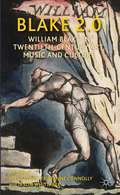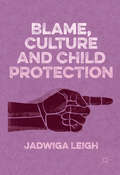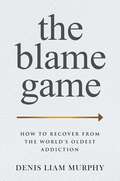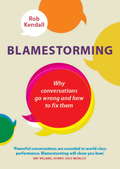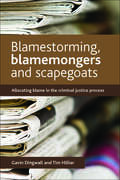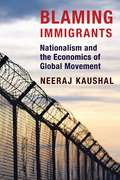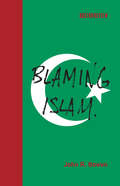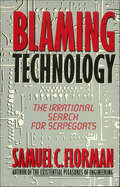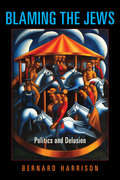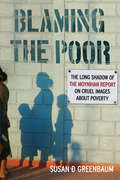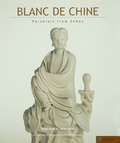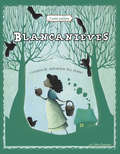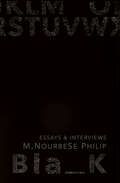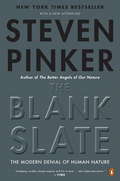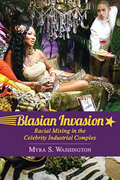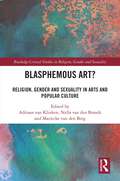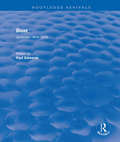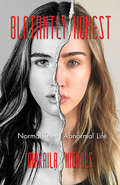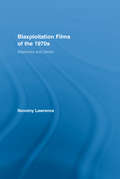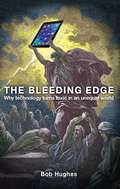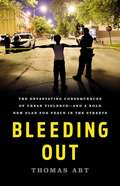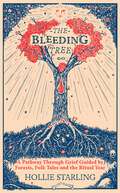- Table View
- List View
Blake 2.0
by Steve Clark Tristanne Connolly Jason WhittakerBlake said of his works, 'Tho' I call them Mine I know they are not Mine'. So who owns Blake? Blake has always been more than words on a page. This volume takes Blake 2. 0 as an interactive concept, examining digital dissemination of his works and reinvention by artists, writers, musicians, and filmmakers across a variety of twentieth-century media.
Blame, Culture and Child Protection
by Jadwiga LeighIn recent years child protection issues have dominated media and public discourse in the UK. This book offers a unique perspective by giving voice to those social workers working within a profession which has become increasingly embedded in a culture of blame. Exploring how statutory child protection agencies function, Leigh also reveals how ‘organisational culture’ can significantly affect the way in which social work is practised. Providing a comparative analysis between the UK and Belgium, Leigh uses ethnography to illuminate the differences between the settings by examining how interactions and affected atmospheres impact on their identities. This book reveals how practitioners perceive themselves differently in such environments and explores the impact this has on their identity as well as the work they carry out with children and families. Leigh’s enquiry and compelling critique into social work, identity and organisations calls for mutual understanding and respect, rather than a culture of blame.
The Blame Game: How to Recover from the World's Oldest Addiction
by Denis Liam MurphyHonest happiness and effortless living are possible. You just have to heal from a blame addiction you didn&’t know you had.Life is designed to be effortless. It might not seem like it right now, but a deep sense of confidence, freedom, and serenity is attainable regardless of your situation. All you need to do is address ONE habit. One that you didn&’t know you had. Anxiety, depression, anger, shame, and guilt are all symptoms of your blame addiction. Spend a month on the BLAME recovery process. Within 30 days… YOUR MENTAL HEALTH WILL IMPROVE. YOUR PHYSICAL PERFORMANCE WILL BE ENHANCED. YOUR ENERGY LEVELS WILL INCREASE. YOUR LIFE WILL CHANGE. From the very first chapter of The Blame Game, you will not only start to release years of built-up frustration, resentment, and sadness, you will begin to find out who you honestly are—all so you can find out what your true purpose is.
Blamestorming
by Rob KendallWinner of the 2015 COVR Award for Best Self-Help Book!Blamestorming outlines the reasons why our daily conversations go wrong, explains how to respond when they do and provides tips on how to stop them going wrong in the first place. Based on his experience as a highly respected communications coach for international companies and business professionals, Rob Kendall provides a practical guide to achieving more rewarding and effective interactions with everyone in your life - from your boss to your partner. Rob's techniques have been proven to be effective for thousands of people from all walks of life and are presented in an illustrated step-by-step format that makes them easy to put into practice from Day One. Underpinning the book's approach to consistently having better interactions is an explanation of the warning signals that indicate when a conversation is going off track.From the Trade Paperback edition.
Blamestorming
by Rob KendallWinner of the 2015 COVR Award for Best Self-Help Book!Blamestorming outlines the reasons why our daily conversations go wrong, explains how to respond when they do and provides tips on how to stop them going wrong in the first place. Based on his experience as a highly respected communications coach for international companies and business professionals, Rob Kendall provides a practical guide to achieving more rewarding and effective interactions with everyone in your life - from your boss to your partner. Rob's techniques have been proven to be effective for thousands of people from all walks of life and are presented in an illustrated step-by-step format that makes them easy to put into practice from Day One. Underpinning the book's approach to consistently having better interactions is an explanation of the warning signals that indicate when a conversation is going off track.From the Trade Paperback edition.
Blamestorming
by Rob KendallBlamestorming outlines the reasons why our daily conversations go wrong, explains how to respond when they do and provides tips on how to stop them going wrong in the first place. Based on his experience as a highly respected communications coach for international companies and business professionals, Rob Kendall provides a practical guide to achieving more rewarding and effective interactions with everyone in your life - from your boss to your partner. Rob's techniques have been proven to be effective for thousands of people from all walks of life and are presented in an illustrated step-by-step format that makes them easy to put into practice from Day One. Underpinning the book's approach to consistently having better interactions is an explanation of the warning signals that indicate when a conversation is going off track.
Blamestorming, Blamemongers and Scapegoats: Allocating Blame in the Criminal Justice Process
by Gavin Dingwall Tim HillierAvailable Open Access under CC-BY-NC-ND licence We live in a society that is increasingly preoccupied with allocating blame: when something goes wrong someone must be to blame. Bringing together philosophical, psychological, and sociological accounts of blame, this is the first detailed criminological account of the role of blame in which the authors present a novel study of the legal process of blame attribution, set in the context of criminalisation as a social and political process. This timely and topical book will be essential reading for anyone working or researching in the criminal justice field. It will also be of wider interest to anyone wishing to discover the role of blame in modern society.
Blaming Immigrants: Nationalism and the Economics of Global Movement
by Neeraj KaushalImmigration is shaking up electoral politics around the world. Anti-immigration and ultranationalistic politics are rising in Europe, the United States, and countries across Asia and Africa. What is causing this nativist fervor? Are immigrants the cause or merely a common scapegoat?In Blaming Immigrants, economist Neeraj Kaushal investigates the rising anxiety in host countries and tests common complaints against immigration. Do immigrants replace host country workers or create new jobs? Are they a net gain or a net drag on host countries? She finds that immigration, on balance, is beneficial to host countries. It is neither the volume nor pace of immigration but the willingness of nations to accept, absorb, and manage new flows of immigration that is fueling this disaffection. Kaushal delves into the demographics of immigrants worldwide, the economic tides that carry them, and the policies that shape where they make their new homes. She demystifies common misconceptions about immigration, showing that today’s global mobility is historically typical; that most immigration occurs through legal frameworks; that the U.S. system, far from being broken, works quite well most of the time and its features are replicated by many countries; and that proposed anti-immigrant measures are likely to cause suffering without deterring potential migrants. Featuring accessible and in-depth analysis of the economics of immigration in worldwide perspective, Blaming Immigrants is an informative and timely introduction to a critical global issue.
Blaming Islam (Boston Review)
by John R. BowenWhy fears about Muslim integration into Western society—propagated opportunistically by some on the right—misread history and misunderstand multiculturalism. In the United States and in Europe, politicians, activists, and even some scholars argue that Islam is incompatible with Western values and that we put ourselves at risk if we believe that Muslim immigrants can integrate into our society. Norway's Anders Behring Breivik took this argument to its extreme and murderous conclusion in July 2011. Meanwhile in the United States, state legislatures' efforts to ban the practice of Islamic law, or sharia, are gathering steam—despite a notable lack of evidence that sharia poses any real threat.In Blaming Islam, John Bowen uncovers the myths about Islam and Muslim integration into Western society, with a focus on the histories, policy, and rhetoric associated with Muslim immigration in Europe, the British experiment with sharia law for Muslim domestic disputes, and the claims of European and American writers that Islam threatens the West. Most important, he shows how exaggerated fears about Muslims misread history, misunderstand multiculturalism's aims, and reveal the opportunism of right wing parties who draw populist support by blaming Islam.
Blaming Technology: The Irrational Search for Scapegoats
by Samuel C. FlormanBlaming Technology: The Irrational Search for Scapegoats is Samuel C. Florman's 1981 discussion of the state of technology and engineering in the United States, including the pros and cons, and the public's perceptions and opinions.
Blaming the Jews: Politics and Delusion (Studies in Antisemitism)
by Bernard HarrisonIn recent years Western countries have seen a proliferation of antisemitic material in social media, and attacks on Jews such as that on the Tree of Life synagogue in Pittsburgh in 2018. Much of this has stemmed, not from personal hostility to Jews on the part of this or that individual, but from a resurgence in groups at both ends of politics of the ancient delusion that "the Jews" collectively dominate world affairs and lie at the root of all the world's evils. In Blaming the Jews author Bernard Harrison, offers a new and unique analysis of this second and far more dangerous form of antisemitism and its persistence as a cultural phenomenon. Questioning the assumption that antisemitism affects or targets only Jews, he demonstrates that, allowed to go unrecognised or unchecked, antisemitism is potentially damaging to us all. In a world where rhetoric is fashioned on stereotypes and driven by political ideology, Harrison argues it is our responsibility to be vigilant in exposing the delusions of antisemitism and their consequences for Jews and non-Jews alike.
Blaming the Poor
by Susan D. GreenbaumIn 1965, the late Senator Daniel Patrick Moynihan--then a high-ranking official in the Department of Labor--sparked a firestorm when he released his report "The Negro Family," which came to be regarded by both supporters and detractors as an indictment of African American culture. Blaming the Poor examines the regrettably durable impact of the Moynihan Report for race relations and social policy in America, challenging the humiliating image the report cast on poor black families and its misleading explanation of the causes of poverty. A leading authority on poverty and racism in the United States, Susan D. Greenbaum dismantles Moynihan's main thesis--that the so called matriarchal structure of the African American family "feminized" black men, making them inadequate workers and absent fathers, and resulting in what he called a tangle of pathology that led to a host of ills, from teen pregnancy to adult crime. Drawing on extensive scholarship, Greenbaum highlights the flaws in Moynihan's analysis. She reveals how his questionable ideas have been used to redirect blame for substandard schools, low wages, and the scarcity of jobs away from the societal forces that cause these problems, while simultaneously reinforcing stereotypes about African Americans. Greenbaum also critiques current policy issues that are directly affected by the tangle of pathology mindset--the demonization and destruction of public housing; the criminalization of black youth; and the continued humiliation of the poor by entrepreneurs who become rich consulting to teachers, non-profits, and social service personnel. A half century later, Moynihan's thesis remains for many a convenient justification for punitive measures and stingy indifference to the poor. Blaming the Poor debunks this infamous thesis, proposing instead more productive and humane policies to address the enormous problems facing us today.
Blanc de Chine: History and Connoisseurship Reviewed
by John AyersDehua porcelain, or Blanc de Chine as it is known in the West, is pure ivory-white porcelain made at the Dehua kilns in the southern Chinese province of Fujian. It rose to international significance in the 17th century and inspired aristocratic patronage in the development of European porcelain. Its popularity at home and abroad continued and the k
Blancanieves: 4 cuentos predliectos de alrededor del mundo (Cuentos multiculturales)
by Jessica GundersonThink there's just one fairy tale with a beautiful girl and an evil stepmother? Think again! Cultures all around the world have their own Snow White stories. Visit Albania, Germany, Mozambique, and Turkey, and find out who meets 40 dragons instead of "seven dwarfs," and on whose forehead a bright star shines. Fully translated Spanish text.
Blank: Essays and Interviews
by M. Nourbese PhilipBlank is a collection of previously out-of-print essays and new works by one of Canada's most important contemporary writers and thinkers.Through an engagement with her earlier work, M. NourbeSe Philip comes to realize the existence of a repetition in the world: the return of something that, while still present, has become unembedded from the world, disappeared. Her imperative becomes to make us see what has gone unseen, by writing memory upon the margin of history, in the shadow of empire and at the frontier of silence.In heretical writings that work to make the disappeared perceptible, Blank explores questions of race, the body politic, timeliness, recurrence, ongoingness, art, and the so-called multicultural nation. Through these considerations, Philip creates a linguistic form that registers the presence of what has seemingly dissolved, a form that also imprints the loss and the silence surrounding those disappearances in its very presence.
The Blank Slate: The Modern Denial of Human Nature
by Steven PinkerIn The Blank Slate, Steven Pinker, one of the world's leading experts on language and the mind, explores the idea of human nature and its moral, emotional, and political colorings. With characteristic wit, lucidity, and insight, Pinker argues that the dogma that the mind has no innate traits-a doctrine held by many intellectuals during the past century-denies our common humanity and our individual preferences, replaces objective analyses of social problems with feel-good slogans, and distorts our understanding of politics, violence, parenting, and the arts. Injecting calm and rationality into debates that are notorious for ax-grinding and mud-slinging, Pinker shows the importance of an honest acknowledgment of human nature based on science and common sense.
Blasian Invasion: Racial Mixing in the Celebrity Industrial Complex (Race, Rhetoric, and Media Series)
by Myra S. WashingtonMyra S. Washington probes the social construction of race through the mixed-race identity of Blasians, people of Black and Asian ancestry. She looks at the construction of the identifier Blasian and how this term went from being undefined to forming a significant role in popular media. Today Blasian has emerged as not just an identity Black/Asian mixed-race people can claim, but also a popular brand within the industry and a signifier in the culture at large. Washington tracks the transformation of Blasian from being an unmentioned category to a recognized status applied to other Blasian figures in media.Blasians have been neglected as a meaningful category of people in research, despite an extensive history of Black and Asian interactions within the United States and abroad. Washington explains that even though Americans have mixed in every way possible, racial mixing is framed in certain ways, which almost always seem to involve Whiteness. Unsurprisingly, media discourses about Blasians mostly conform to usual scripts already created, reproduced, and familiar to audiences about monoracial Blacks and Asians.In the first book on this subject, Washington regards Blasians as belonging to more than one community, given their multiple histories and experiences. Moving beyond dominant rhetoric, she does not harp on defining or categorizing mixed race, but instead recognizes the multiplicities of Blasians and the process by which they obtain meaning. Washington uses celebrities, including Kimora Lee, Dwayne Johnson, Hines Ward, and Tiger Woods, to highlight how they challenge and destabilize current racial debate, create spaces for themselves, and change the narratives that frame multiracial people. Finally, Washington asserts Blasians as evidence not only for the fluidity of identities, but also for the limitations of reductive racial binaries.
Blasphemous Art?: Religion, Gender and Sexuality in Arts and Popular Culture (ISSN)
by Adriaan Van Klinken van den Brandt, Nella van den Berg, MarieckeThis book explores the critical and transformative potential of arts and popular culture for constructions of religion, gender and sexuality. Doing so, it deploys and develops the notion of blasphemous art, honouring and building on the work of Anne-Marie Korte. Deliberately articulated with a question mark, Blasphemous Art? raises questions about the spaces, methods and resources available to individuals and communities at the gendered, sexual and racialized margins of society to tell their stories, claim their bodies and perform symbolic and sacred meaning, and it analyses the productive effects – both aesthetically, politically and theoretically – of such provocative work. The book focuses on a wide range of artistic and cultural expressions, featuring case studies from across Europe, South Africa, Israel and the United States. Drawing on feminist, queer and postcolonial perspectives, the book reveals the critical, constructive and imaginative potential of the creative arts (broadly defined) and popular culture in its complex and diverse representation of, and engagement with, religious life, belief, text, ritual and practice.
Blast: Vorticism, 1914-1918 (Routledge Revivals)
by Paul Edwards Jane Beckett Deborah Cherry Richard Cork Karin Orchard Andrew WilsonThis title was first published in 2000. Founded in 1914 by Wyndham Lewis and christened by Ezra Pound, the Vorticism movement was a sustained act of aggression against the moribund Victorianism seen as stifling to artistic energies. Inspired by the example of F.T.Marinetti and the Futurists, the Vorticists were nevertheless harshly critical of the Futurists' naive enthusiasm for modernity. They created their own style of geometric abstraction to celebrate the new consciousness of humanity in a mechanized urban environment. But their splintered and discordant style also measured the cost of the psychic disruption that modernity caused. This illustrated guide to the movement covers topics including sculpture, painting, literary Vorticism, women in Vorticism and Vorticist aesthetics.
Blatantly Honest: Normal Teen, Abnormal Life
by Makaila Nichols“[Makaila] shoots straight about the pressures of growing up in such a highly social climate and offers much-needed advice for other teens.” —David Boreanaz, actor, director, producer of film and televisionBeing a teenager today is one of the hardest jobs in the world. You have grades to maintain, obligations to extra-curricular activities, and soul-crushing pressure to excel at everything so colleges take notice. On top of it all, you’re forced to act as your own public relations manager because, thanks to social media, every bit of your life is on display. No one knows that better than teen model, actress, and author Makaila Nichols. Nichols’ book, Blatantly Honest, is filled with peer-to-peer advice on navigating life as a teen in a world that begs young people to grow up before they’re really ready.Unlike books for teens written from an adult perspective, Blatantly Honest offers real, relatable advice based on lessons learned in today’s world. After all, adults today have no experience being a teen in a social climate where peers have immediate, constant access to one another. Despite her rising fame, Nichols has struggled through body image issues, dating disasters, friendship failures and bullying. In this refreshing, open, and honest book, Nichols offers hard-earned advice on these tough topics and more.“It’s a daring undertaking to be honest about ourselves. Makaila genuinely shares her experiences, and it is such a true gift to her peers for them to realize that we all deal with our insecurities.” —Frederique van der Wal, supermodel and entrepreneur“Makes you feel like you’re talking with an older sister or a close friend—but this isn’t your mother’s advice.” —Anna Caltabiano, teen author and influencer
Blaxploitation Films of the 1970s: Blackness and Genre (Studies in African American History and Culture)
by Novotny LawrenceDuring the early years of the motion picture industry, black performers were often depicted as shuckin’ and jivin’ caricatures. Specifically, black males were portrayed as toms, coons and bucks, while the mammy and tragic mulatto archetypes circumscribed black femininity. This misrepresentation began to change in the 1950s and 1960s when performers such as Dorothy Dandridge and Sidney Poitier were cast in more positive roles. These performers paved the way for the black exploitation or blaxploitation movement, which began in 1970 and flourished until 1975. The movement is characterized by films that feature a black hero or heroine, black supporting characters, a predominately black urban setting, a display of black sexuality, excessive violence, and a contemporary rhythm and blues soundtrack. Blaxploitation films were made across varying genres, but the questionable elements of some of the pictures caused them to be referred to as "blaxploitation" films with little or no regard given to their generic categorization. This book examines how Cotton Comes to Harlem (1970), Blacula (1972), The Mack (1973), and Cleopatra Jones (1973) can be classified within the detective, horror, gangster, and cop action genres, respectively, and illustrates the manner in which the inclusion of "blackness" represents a significant revision to the aforementioned genres.
The Bleeding Edge: Why Technology Turns Toxic in an Unequal World
by Bob Hughes<P>Capitalism likes us to believe in the steady, inevitable march of progress, from the abacus to the iPad. But the historical record tells of innumerable roads not taken, all of which could have led to better, more equal worlds, and still can. <P>Academic and activist Bob Hughes puts flesh on the bones of the idea that 'another world is possible', using as evidence the technology that capitalism claims as quintessentially its own: the computer in all its forms. <P>Contrary to popular belief capitalism does not do innovation well - instead suppressing or appropriating it. This book shows that great innovations have never emerged from capitalism per se, but always from the utopian moments that occur behind the capitalist's back. And when it does embrace an innovation, the results are often the diametric opposite of what the innovators intended.In this thorough and meticulous work Hughes argues that if we only prioritized equality over materialism then superior and more diverse technologies would emerge leading to a richer more sustainable world. <P>Bob Hughes is an academic, activist, and author. Formerly he taught electronic media Oxford Brookes University and now spends his time researching and campaigning against inequality. He is author of Dust or Magic, a book for digital multimedia workers, about how people "do good stuff with computers." He is a member of No One is Illegal, which campaigns for the total abolition of immigration controls, for whom he has written many articles.
Bleeding Out: The Devastating Consequences of Urban Violence--and a Bold New Plan for Peace in the Streets
by Thomas AbtFrom a Harvard scholar and former Obama official, a powerful proposal for curtailing violent crime in America Urban violence is one of the most divisive and allegedly intractable issues of our time. But as Harvard scholar Thomas Abt shows in Bleeding Out, we actually possess all the tools necessary to stem violence in our cities.Coupling the latest social science with firsthand experience as a crime-fighter, Abt proposes a relentless focus on violence itself -- not drugs, gangs, or guns. Because violence is "sticky," clustering among small groups of people and places, it can be predicted and prevented using a series of smart-on-crime strategies that do not require new laws or big budgets. Bringing these strategies together, Abt offers a concrete, cost-effective plan to reduce homicides by over 50 percent in eight years, saving more than 12,000 lives nationally. Violence acts as a linchpin for urban poverty, so curbing such crime can unlock the untapped potential of our cities' most disadvantaged communities and help us to bridge the nation's larger economic and social divides.Urgent yet hopeful, Bleeding Out offers practical solutions to the national emergency of urban violence -- and challenges readers to demand action.
The Bleeding Tree: A Pathway Through Grief Guided by Forests, Folk Tales and the Ritual Year
by Hollie StarlingIt was the last of the ebbing days, the brink of the new season. It was the murky hours, the clove between sunset and sunrise. It was a tall tree with deep roots and it had been bleeding for a long while.As summer falls into autumn, Hollie Starling is hit by the heart-stopping news that her father has died by suicide. Thrust into a state of 'grief on hard mode', Hollie feels underserved by current attitudes toward grief and so seeks another way through the dark.Following her first year without her father, Hollie embraces her lifelong interest in folklore and turns to the healing power of nature, the changing seasons and the rituals of ancient communities. The Bleeding Tree is an unflinching year-zero guidebook to grief that shows us that by looking back to past traditions of bereavement we can all find our own way forward.'Starling's account of family life is riveting and narrated with grace and honesty, counterpointing the personal with the mythic.' - Irish Times
